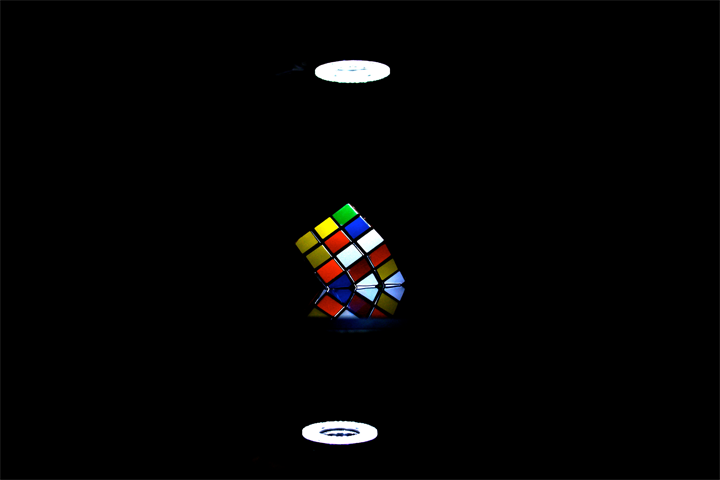- Installation: ^3, *a.k.a.*3, *a.k.a.* “cubed”
- Concept + Design: Douglas Edric Stanley
- Exhibition: ZeroOne San Jose
- Dates: August 7 - 13, 2006
- Platform: shockwave
- Video (via YouTube) : Cubed Demo, Douglas Edric Stanley - Rubik’s Cube DJ

³, a.k.a. ^3, a.k.a. ‘cubed’ is a musical sequencer integrated into a Rubik’s Cube®. Each face of the cube uses a different instrument to play notes generated according to the colors on that face. Each face is played in a loop, as if it were a single “track” on a basic electronic music sequencer. Therefore by manipulating the colors on the cube, users generate different sound algorithms within the sequencer.

³, a.k.a. ^3, a.k.a. ‘cubed’ est une séquenceur musicale intégré dans un Rubik’s Cube®. Chaque face du cube représente un instrument et joue les couleurs sur cette face en tant que notes. Chaque face est joué en boucle, comme s’il s’agissait d’une « piste » dans un séquenceur musicale.
Since the video from my last post was referenced over at Metafilter, I’ve received a lot of traffic. There are some interesting critiques over there, although I have heard a few of them before in private. The most common is the fact that you have to have the cube analyzed, instead of manipulating the emulated cube real-time. I will adress these issues in more detail at a later time, but it should be said for now that I have tried a real-time version, only to be frustrated by the lack of musical advantages — i.e. it just made everything messy, as it is ultimately a real-time sequencing instrument, and not a real-time note-for-note instrument. Added to this, is the problem of technically analyzing a cube without adding active electronics into the cube itself. I am researching the use of passive electronics in the cube, but that still means designing a Frankencube. I want people to Bring Your Own Rubik’s Cube (yes, that stands for BYORC Music), and even use the cube as a sort of floppy (floppy cube?) where you can “store” each composition and move back and forth during the performance.
Shortfuse quite correctly reminds me that I had originally spoken of the fluidity of a guitar. Although my inspiration was right (I think), the idea of using the guitar as an example was more confusing than obvious. A guitar, like a piano, works with discrete notes that are often played in combinations. On the guitar these notes are stroked using various rythmic motifs, i.e. via strumming. This is what I originally was interrested in: you have the permutation on the neck that you stroke with your other hand — permutation + interpretation. But of course the way the guitar is stroked is so much more expressive because variations can also be applied on the neck, and can lead to all sorts of amazing improvisations, putting it in a whole other league. I probably should have just avoided the guitar comparison altogether and talked about making a kick-ass interface for Max/MSP.
Like I said, there will be more information on the design of the instrument when ZeroOne opens and people can play it live. Also the conceptual framework for this instrument should be clearer. See you there.

Original Comments:
del
fyi: http://www.artificiel.org/cubing for whatever it worth…